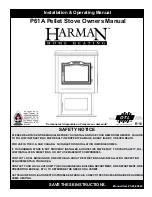
10
ABOUT VIKING 40
Manufacturer's declaration
This product has been manufactured in accordance with
the product type approval document, which includes
assembly and maintenance instructions as accompanying
documents.
General
Viking 40 is made in Austria with a tradition dating back
to the 1930s. The range consists of high quality steel
with cast iron doors. The combustion chamber is lined
with chamotte stone, and a cast iron grid forms the
fireplace base.
The range is equipped with an upper of steel or glass
ceramic (optional) that serves as a single large cooker /
hot plate. The basic structure of the range consists of
machine-welded sheet metal plates to which external
plates are screwed. The fireplace door is equipped with
a double, air-polished ceramic hardened glass that allows
for a wonderful and soot-free view of the fire. Maximum
heat output and low wood consumption are obtained
due to the fact that the hearth and gaps are equipped
with a fireproof sealant, and by burning the wood under
automatic supply of preheated secondary air through the
holes in the hearth’s back plate. Primary air is supplied
above the door glass.
Chimney
The flue diameter should be at least 125 mm, have a
chimney draft of at least 0.12 mbar and a recommended
minimum height of 3.5 m on the flue (calculated from the
fireplace's connection).
Adjustable cooking height
The total height of the hearth is adjustable between
850-920 mm. Lift up the hearth in the front so that the
hearth rests on the rear adjusting screws to more easily
adjust the front adjusting screws and vice versa. The four
adjusting screws have a M10 thread with a key width of
17 mm.
Convection cabinet
When mounting close to flammable components, fire-
resistant spacers and a fire protection kit are required.
For dimensions and description see pages 12-15.
HERE’S HOW YOUR VIKING 40
WORKS
Convection air
In addition to radiating heat, the Viking 40 is also
equipped with convection technology. This means that
the cool room air is sucked into the sides of the wood
burning range, heated, pushed out through the oval holes
on the hob and finally flows into the room. This allows
the hot air to spread more easily around the room.
Combustion air
The primary air is supplied when the glass door of
the range is left half-open during the filling up of
firewood and during the ignition phase. Secondary
air is supplied through the butterfly valve under the
range. The secondary air is then heated in the range and
disseminates into the fire through the holes in the range’s
back plate.
Butterfly valve
WARNING! THE WOOD BURNING RANGE GETS VERY HOT
When burning, some areas of the wood burning range become very hot and can cause burns when touched.
Also, be careful with heat radiating through the door glass. If combustible material is placed closer than the
specified safety distance, it can quickly catch fire. Smouldering combustion can cause rapid gas ignition with
the risk of injury to persons and property.
0 = Closed
1 = Fully open.










































